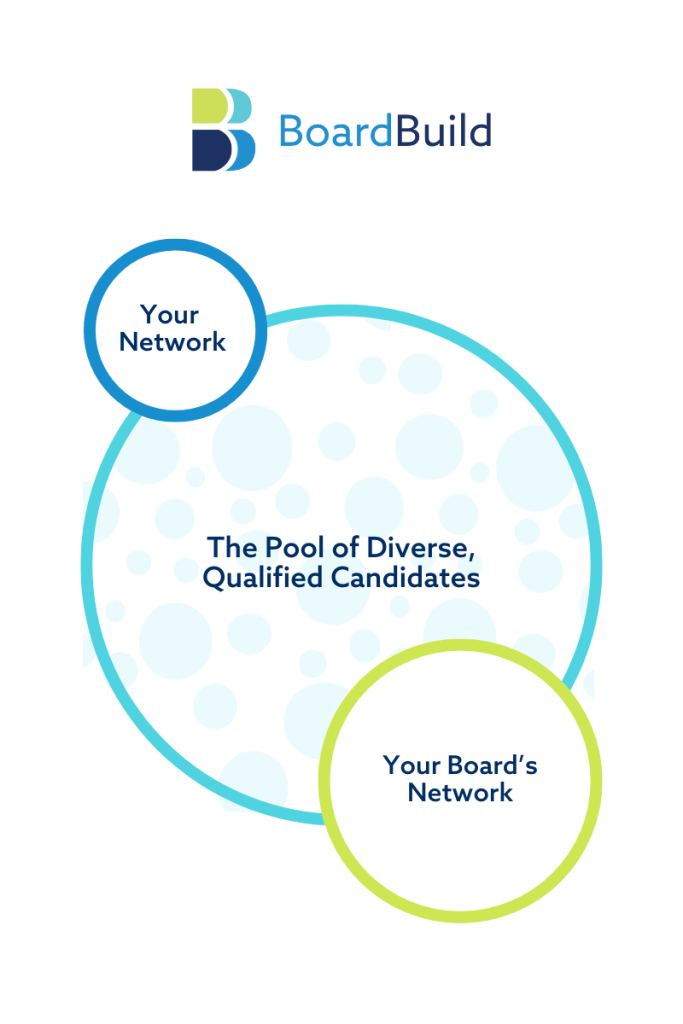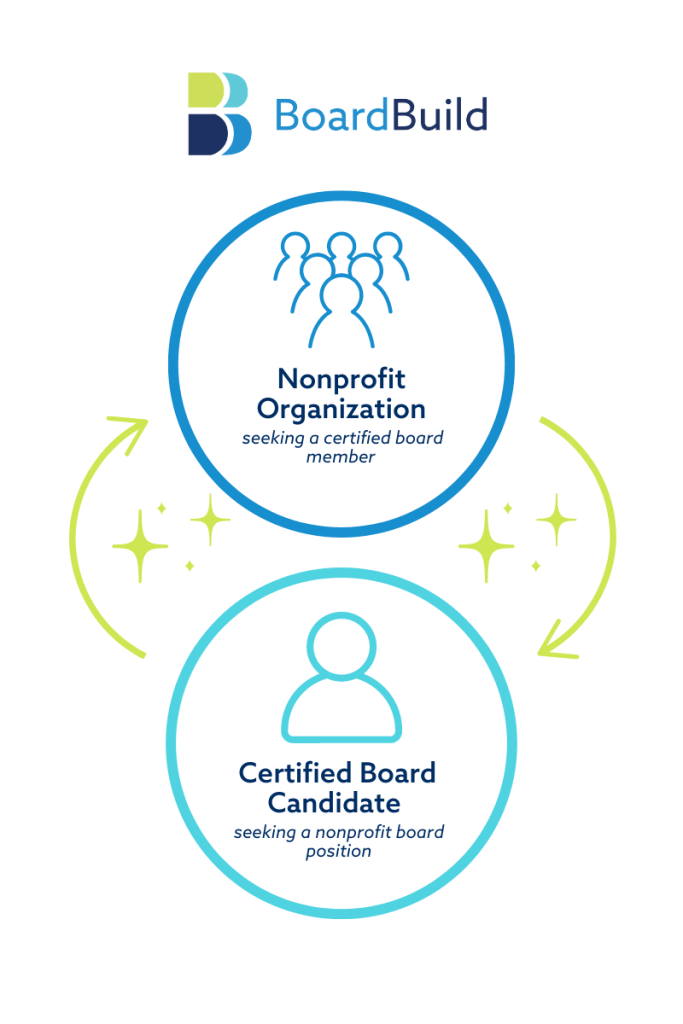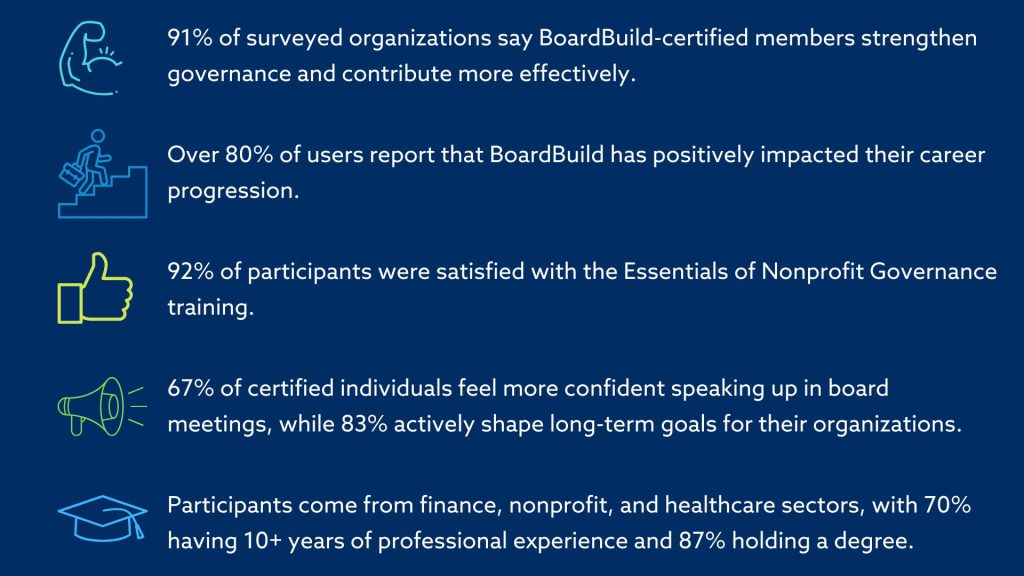
Nonprofit Boards Are Failing Us. Here’s What We Can Do About It.
Why it’s time to rethink how we recruit engaged, impactful nonprofit board members.
A nonprofit CEO friend of mine recently mentioned the need to grow her board and infuse it with a wider variety of experiences and perspectives. I told her about BoardBuild — an algorithm-based matching platform that prepares leaders with board governance certification, then pairs them with nonprofit boards seeking their exact skills, knowledge, and expertise. Her response was a familiar one.
“The platform is pretty slick,” she said, “but I still think boards should be built on relationships.”
“So should marriages,” I countered, “but you have to meet that special someone before you can begin the process of developing a relationship.”
Her philosophy on board recruitment is commonly held. That’s the way we normally do it. Nonprofit board members are recruited through a combination of personal referrals and leveraging the networks of current board members. But has this traditional way of finding new board members generated effective nonprofit governance?
According to the National Council for Nonprofits, “Board members are the fiduciaries who steer the organization towards a sustainable future by adopting sound, ethical, and legal governance and financial management policies, as well as by making sure the nonprofit has adequate resources to advance its mission.” Yet, recent surveys across the sector tell a conflicting tale.
There are more nonprofits this year than last year, and 71% of them report an increase in demand for their services; but 68% of them plan to cut programs over the next two years, and 42% report insufficient resources and funding. The number of new donors has fallen by over 18% and about 1/3 of nonprofits operating today will likely shutter their doors within ten years.
And this data was collected BEFORE the rapid shifts now taking place in the nonprofit funding landscape!
If sustainability and resources are the principle responsibilities of boards, ours aren’t getting it done; and board recruitment – how we bring members to the table – is likely the key contributor to this ineffectiveness.
The good news is there’s a different way.
To understand the effective shaping of impactful boards, it is helpful to first understand two important realities of nonprofit board recruitment. At BoardBuild, we call these “The Pool,” and “The Magic.”
The Pool
When I took the helm as CEO at United Way of Tarrant County, I had a pretty homogenous board – mostly male, mostly older, mostly white, and many were bankers who lived and worked in the Fort Worth area. They were wonderful people who cared about the mission and brought the influence and affluence we generally looked for in nonprofit board members. They also represented a body that was not reflective of the broader community we served.

I needed to intentionally diversify my board in five key areas:
1. Age
2. Gender
3. Race & Ethnicity
4. Industry & Expertise
5. Geography
I asked my existing board members to bring in talent from each of these five demographics and, despite their best efforts, they couldn’t deliver. Why? They were limited to their own networks, and those networks were filled with individuals who were very similar to them. Sure, they knew people from the larger pool of candidates, but their relationships there were not strong enough to support the ask of serving on our board.
This struggle isn’t unique to United Way, or even to our region of Texas. No matter how well-connected and influential a nonprofit board is, they can only effectively recruit board members from their spheres of influence. Most often the people found in these networks are individuals who look like them, work with them, have similar interests, and live similar lives.
Because your board members can reliably be counted on to bring you clones of themselves as board candidates, recruiting from your board members’ networks makes diversification sluggish at best, and impossible at worst.
“OK, so you’ve sold me on the need to reach a larger, more diverse pool of candidates, “she said. “How do I know they’ll make impactful, engaged, and contributory board members?”
“Well, that’s where the magic comes in, ” I replied.
The Magic
Training is great to hone good boards into great boards, but no amount of training can turn a group of uninspired people into an engaged board of directors; just like no amount of sharpening can turn a lump of clay into a knife. You have to start with the right composition.
Sometimes the board recruitment process is transactional. A company like Lockheed Martin, a leading global security and defense contractor “always had a seat on our board,” so when the representative who occupies that seat retires or relocates, the company chooses a replacement. At best, this replacement is “subject to approval by the board,” but it’s extremely rare for any nonprofit to refuse a board member nominated by a donor company. In these cases, it’s best to accept what you’ve been given and hope this individual will be engaged in the mission.

When not transactional, often board member recruitment involves some level of cajoling, compromising, or otherwise talking someone into joining the board.
At the beginning of my nonprofit career, I prided myself in going after people with “affluence and influence” to join my board. I even used this as a tagline with my team, encouraging them to help me find such folks. And we were successful! Successful enough to experience years of frustration as people with huge capacity to support our cause did nothing but take up a seat.
This taught me a simple, basic truth about nonprofit governance leaders. They’ll support what they want to support. Expecting to sell them on your cause so they’ll give up their valuable time, resources, and energy supporting you is a fool’s errand.
Transactional processes or compromising passion for potential are both situations that result in a less-than-optimal board experience for both the board member and the organization. Both lay a shaky foundation and represent a poor start to the relationship-building process my friend was talking about.
But what happens when people are seeking the opportunity to serve?
How does this dynamic change when nonprofits are browsing a pool of candidates who want to be selected?
What would the result be if qualified, trained, enthusiastic individuals were then placed on nonprofit boards?
Nonprofit boards want and need to find passionate, engaged board members. When this perspective is shared by both the board and the candidate, we call this The Magic of the Mutual Search.
Does The Magic contribute to increased sustainability in nonprofits? We think so, and a recent Maya Consulting study puts real numbers to the benefits of our approach.

Prominent nonprofit leaders from across the country who source board members from our platform tell us these members are among the most engaged, participatory, and contributory.
“United Way of Tarrant County continues to benefit greatly from our relationship with BoardBuild. A prime example is in the quality board and committee members we have been able to attract over the past few years. Without fail, the folks we’ve been fortunate enough to onboard are among our most engaged and energetic board and committee members.“
– Leah King, President & CEO
Ready to transform your board? Begin today by posting your open nonprofit board and committee positions. After completing your posting, you will be given access to thousands of trained, diverse, and qualified candidates for absolutely no cost.
BoardBuild is the innovative solution. Dip into The Pool today and begin to discover The Magic.


TD Smyers is the CEO of BoardBuild. He’s also one of the platform’s founders, a retired US Navy Captain, and former CEO of United Way of Tarrant County and the North Texas Region of the American Red Cross. He knows leadership changes things and he’s experienced the state of America’s nonprofit leadership first-hand, so he’s committed to leveraging technology like BoardBuild to intentionally evolve our governance leadership to be diverse, strong, and impactful.





This is an exceptional and innovative way to locate talented and strong board members who want to serve. The concept of the Pool and the Magic makes a whole lot of sense. It also solves a number of important issues related to a corporation’s and nonprofit’s desire to make some great matches. Love the concept and how it works TD!
Thanks for joining the conversation, Mark! You’ve had feet in both camps, so we appreciate your perspective.